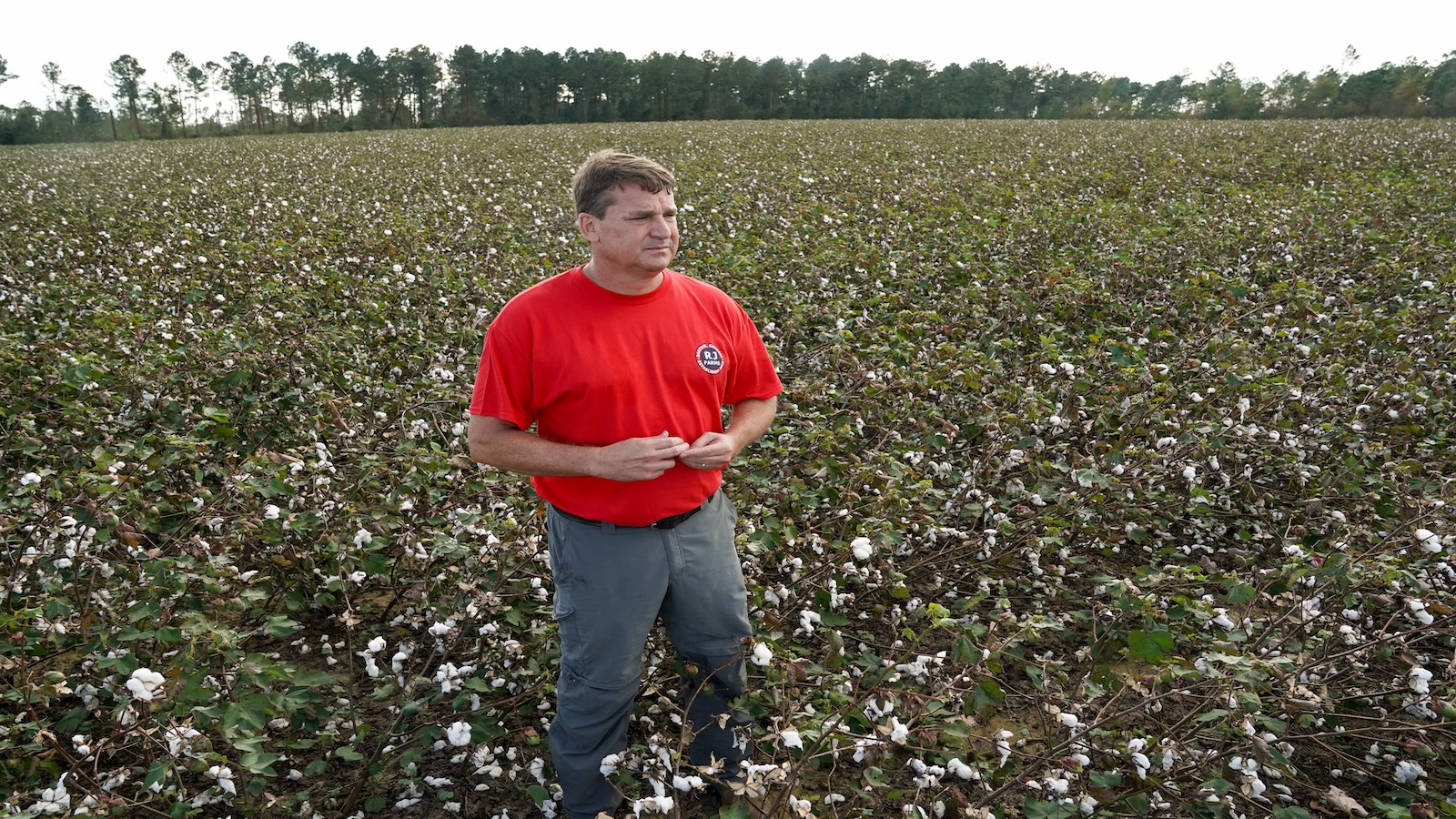When Hurricane Helene made landfall in Florida three weeks ago, Jason Madison was alone at his place, which doubled as a shrimp storefront in Keaton Beach. As the wind began to roar and the bay started to roil, Madison decided to flee. It was the right call. When he returned home the next morning, he found that the nearly 20-foot storm surge had torn it apart. Dead fish and broken furniture littered the landscape. Most everything in the building was lost, taking with it a cornerstone of his livelihood.
“I had five tanks under there where I stored shrimp, because we sell everything alive, but all that’s all gone now,” said Madison, a commercial bait and shrimp farmer for the last 23 years. He paused to take in the strewn debris. “Well, the pieces are around.” Anything Helene left behind is a waterlogged shell of what used to be. He doesn’t know how, or even if, he’ll rebuild.
Stories like this are playing out all through the Southeast. The storm battered six states, causing billions of dollars in losses to crops, livestock, and aquaculture. Just 13 days later, Milton barreled across Florida, leaving millions without power and hampering ports, feed facilities, and fertilizer plants along the state’s west coast.
Preliminary estimates suggest Helene, one of the nation’s deadliest and costliest hurricanes since Katrina in 2005, upended hundreds of thousands of businesses throughout the Southeast and devastated a wide swath of the region’s agricultural operations. Milton’s impact was more limited, but the two calamities are expected to reduce feed and fertilizer supplies and increase production costs, which could drive up prices for things like chicken and fruit in the months and years to come.
The compounding effect of the two storms will create “a direct impact on agricultural production,” said Seungki Lee, an agricultural economist at Ohio State University.
When a farm, an orchard, a ranch, or any other agricultural operation is damaged in a disaster, it often leads to a drop in production, or even brings it to a screeching halt. That slowdown inevitably ripples through the companies that sell things like seeds and fertilizer and equipment. Even those growers and producers who manage to keep going — or weren’t directly impacted at all — might find that damage to roads and other critical infrastructure hampers the ability to bring their goods to market.
Early reports indicate this is already happening. Downed trees, flooded roads, and congested highways have disrupted key transport routes throughout the Southeast, while ports across the region suspended operations because of the storms, compounding a slowdown that followed a dockworker strike along the Gulf and East Coast.
Helene dismantled farming operations that serve as linchpins for the nation’s food supply chain. Cataclysmic winds destroyed hundreds of poultry houses across Georgia and North Carolina, which account for more than 25 percent of the machinery used to produce most of the country’s chicken meat. An analysis by the American Farm Bureau Federation found that the region hit by Helene produced some $6.3 billion in poultry products in 2022, with over 80 percent of it coming from the most severely impacted parts of both states. In Florida, the storm flattened roughly one in seven broiler houses, which the Farm Bureau noted, compounding losses throughout the region that “will not only reduce the immediate supply of poultry but also hinder local production capacity for months or even years.”
The storm uprooted groves, vegetable fields, and row crops throughout the region. Georgia produces more than a third of the nation’s pecans, and some growers have lost all of their trees. Farmers in Florida, one of the nation’s leading producers of oranges, bell peppers, sugar, and orchids, also have reported steep production losses, facing an uncertain future. The rain and floods unleashed by Helene hobbled livestock operations in every affected state, with the situation in western North Carolina so dire that local agricultural officials are crowdfunding feed and other supplies to help ranchers who lost their hay to rising water. Those working the sea were impacted as well; clam farmers along the Gulf Coast are grappling with the losses they incurred when Helene’s storm surge ravaged their stocks.

Mario Tama via Getty Images
All told, the counties affected by Helene produce about $14.8 billion in crops and livestock each year, with Georgia and Florida accounting for more than half of that. If even one-third of that output has been lost to the two hurricanes, the loss could reach nearly $5 billion, according to the Farm Bureau.
Preliminary estimates from the Department of Agriculture suggest the one-two punch may incur more than $7 billion in crop insurance payouts. On October 15, the USDA reported allocating $233 million in payments to producers so far.
As bad as it is, it could have been worse both for consumers and for farmers nationwide. Florida is home to the highest concentration of fertilizer manufacturing plants in the nation. Twenty-two of the state’s 25 phosphate waste piles, several owned by industry powerhouse Mosaic, were in Milton’s path. The company, which did not respond to a request for comment, shuttered operations ahead of the storm, and has since announced it sustained “limited damage” to its plants and warehouses. (But the Tampa Bay Times reported that one facility was grappling with water intrusion following Helene and was inundated during Milton, likely sending water polluted with phosphate waste flowing into Tampa Bay.) The storm also halted operations for several days at Port Tampa Bay, which handles around a quarter of the country’s fertilizer exports.
Production impacts from both hurricanes may be felt most acutely by the Sunshine State’s struggling citrus industry, which has long been embattled by diseases and destructive hurricanes. Any additional losses could further inflate costs for goods like orange juice, which reached record highs this year, according to Lee, the agricultural economist. “In the face of hurricane shocks, agricultural production in southern states like Florida will take it on the chin,” he said.
But teasing out the effect of a single storm on consumer prices is not only exceedingly difficult, it requires many years of research, Lee warned. Although all signs indicate that Hurricane Ian was partly responsible for the record food prices that followed that storm in 2022, the strain the hurricane placed on costs compounded other factors, including global conflict, droughts in breadbasket regions and the bird flu epidemic that decimated the poultry sector.
Even so, there’s still a chance that ongoing disruptions to ports and trucking routes could cause “the entire food supply chain to experience additional strain due to rising prices” associated with moving those goods, said Lee. If that turns out to be the case, “eventually, when you go to the supermarket, you will end up finding more expensive commodities, by and large.”
One of the greatest unknowns remains the question of how many storm-weary operations will simply call it quits. Industrial-scale businesses will surely rebound, but the rapid succession of ruinous hurricanes may well discourage family farms and small producers from rebuilding, abandoning their livelihoods for less vulnerable ventures.
“It’s what we call a compound disaster. You’re still dealing with the effects of one particular storm while another storm is hitting,” said economist Christa Court. She directs the University of Florida’s Economic Impact Analysis program, which specializes in rapid assessments of agricultural losses after disasters. “We did see after Hurricane Idalia that there were operations that just decided to get out of the business and do something else because they were impacted so severely.”

Ayurella Horn-Muller / Grist
Madison isn’t sure what’s next for his shrimp operation. He’s too focused on salvaging what he can to think that far ahead. “I don’t really know what I’m going to do,” he said. He hasn’t been able to afford flood insurance, so he’s not sure how much financial support he’ll end up getting to help him rebuild even as he’s still recovering from Hurricane Idalia, which pummeled Florida’s Big Bend area in August. “The last few years, it’s just things are dropping off, and times are getting hard … it’s like, what can you do?”
As the world continues to warm, more and more farmers may find themselves confronting the same question.
Jake Bittle contributed reporting to this story.



